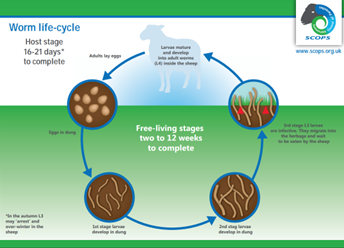The Worms

There are 20 different species of nematodes (aka roundworms) commonly found in Britain that will infect sheep and cattle. Each of these worms have a site in the body that they can be commonly found, e.g. lungs, small intestine or abomasum, and then the disease they cause tends to correlate with the are they are found.
The lifecycle for most nematodes: female worm in the host (e.g. sheep) lays eggs which pass out in the faeces onto pasture ⇒ each egg releases one first stage larva L1 ⇒ L1 develop into L2 ⇒ L2 develops into L3, this is the infective larva that migrates onto herbage and is then ingested by the host ⇒ L3 develop to L4 within the host ⇒ L4 then emerge as adult worms. The length of the lifecycle on pasture is variable and depends on temperature and rainfall, the lifecycle within the host takes around 3 weeks from ingestion of L3 to the passing of eggs in the faeces. This delay is the reason we recommend repeating faecal egg counts regularly.
Worming
Faecal egg counts (FEC) should be performed prior to worming because:
To guide choice of wormer depending on species seen or time of year
To guide whether to worm or to wait and perform another FEC in a few weeks
Collection guidelines:
- Only take samples from freshly deposited faeces (ideally still warm).
- Collect at least 5 grams of faeces or around 7 faecal pellets per individual sample. The more the better!
- Put each sample in to a separate container or bag so that when they are received at the lab they can weigh out the same amount from each sheep sampled to maximise the accuracy of the FEC result.
- Take samples from a minimum of 10 different animals, preferably 15.
- Try to avoid collecting any faeces that are in direct contact with the soil because soil may contain a lot of nematode eggs. Also avoid collecting grass and stones as this can change the sample weight when weighed out at the lab.
If faecal egg counts come back high (usually if over 400 eggs per gram), then we will advise worming some of the group. Targeted selective treatment is where we worm those in the group that are struggling with the worm burden, e.g. dirty bums, poorer body condition, dull, pale mucous membranes. This method of worming reduces resistance in the worm population.
Post-treatment faecal egg counts should be performed to check efficacy of that wormer on the worms on your pasture. If using a yellow wormer take post-treatment samples 7 days post worming, and 14 days for all other wormers. Try and take samples from the same animals in both the pre and post treatment faecal egg count.

All our vets are happy to chat through worming, get in touch if you want to know more!